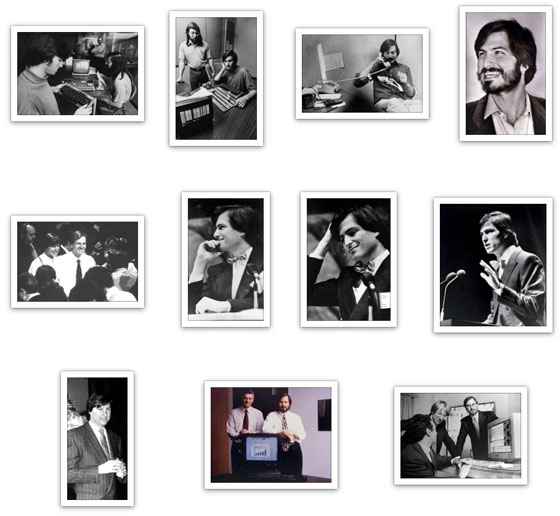Posts tagged 'NeXT'
How expensive the NeXT computers actually were?
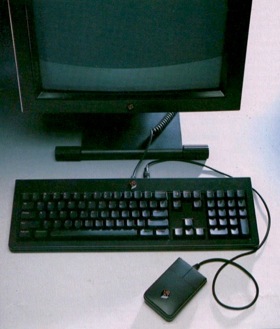
While I was busy doing research for the re-writing of my Long Biography of Steve Jobs, I came across an old link I had bookmarked some years ago: Éric Lévenez’s website. Lévenez is a fellow countryman of mine, who has a long history with UNIX and NeXTSTEP, as you can tell from his webpage. (I can’t say I share his aesthetic inclinations though). He has in his NeXT archives a couple copies of articles written in the early 1990s about the NeXT systems, in the French press. If you are interested in reading them, they are available on this nice dedicated page (look for “SVM” in the Magazines window).
The first article is from July 1989 and introduces the NeXT Cube and its operating system to the French, who still couldn’t buy the computers back then. The article has a very optimistic tone and doesn’t fail to recognize the technical superiority of NeXTSTEP. The tagline proclaims “Why it won’t be possible to design, develop on and use a computer the old ways after NeXT”.
Lost among the technical specs is an interesting table comparing the prices at which the company sold its four computers in the US:

The five rows represent the five configurations of the NeXT systems that could be bought. The two columns represent the University price and the Businessland (NeXT’s retail partner) price —which as you can see cost 50% more. The configs were:
- Standard: 8MB of RAM and a 256MB optical drive
- Academic: standard + laser printer
- Advanced: standard + 330MB hard disk
- Developer: academic + 660MB hard disk
- Server: 16MB of RAM, optical drive and 660MB hard disk


- the Macintosh SE/30, introduced in January 1989 for $6,500, came with a 16 MHz Motorola 68030 and 1MB of RAM built in
- the Macintosh IIcx, March 1989, $5,369, 16 MHz Motorola 68030, 1MB RAM
- the closest to the NeXT Cube is the Macintosh IIci, launched in September 1989 (one year after the NeXT Computer) for $6,269 with the same processor, the Motorola 68030 running at 25 MHz, and 1MB RAM in the default config
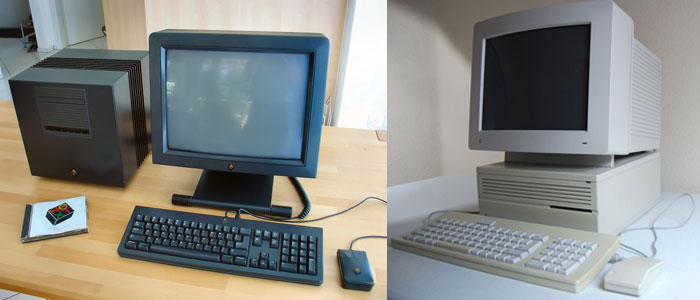

Steve Jobs selling OpenStep on Intel machines at Morgan Stanley, 1994
If you’ve read this far, you probably are as hard-core a fan of Black Hardware as your fellow webmaster. Perhaps you remember that I mentioned a second article on Lévenez’s website. What was it about, you might ask? Well, it was a great relief for me, who sometimes wishes I could have lived during the NeXT days. Indeed, the second article was about the arrival of NeXT to the French market. The Cube was priced… 130,000 Francs of 1990 i.e. 18,000 USD of 1990 —almost twice the US price, and over $32,000 of 2012… Surprise, surprise, I don’t think I could have afforded them anyway!
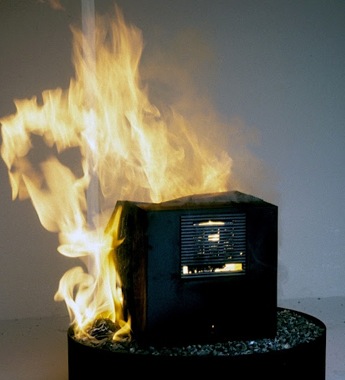
While you wait for tomorrow’s keynote…
- The New Yorker did a story on the history of the computer mouse, back to Xerox PARC and the famous Steve Jobs visit that supposedly inspired Lisa then Macintosh. One of the mouse’s inventors, Malcom Galdwell, recalls what we already know, that Apple didn’t “steal” the mouse from Xerox. Unfortunately the story can only be accessed by subscribers — I didn’t subscribe just to read it. The abstract is here (not very well done). It contains interesting old sketches and pictures of prototypes, as well as quotations from the piece, such as this one:
“I had a series of ideas that I wanted to bounce off [Jobs], and I barely got two words out of my mouth when he he said, ‘No, no, no, you’ve got to do a mouse.’ I was, like,‘What’s a mouse?’ I didn’t have a clue,” Hovey told Gladwell.
(via Cult of Mac)
- We’ve talked about it earlier: the building of the extension of Pixar’s Emeryville campus, Pixar Phase II, is now over. Check it out on the excellent Pixar blog.
- A curious piece of trivia, some study was made to prove that Apple had actually the same effect on fanboys that a religion (or, more appropriately, a cult) on its followers:
As discussed in the new BBC documentary “Secrets of the Superbrands”, when you put an Apple fanatic under an MRI and start mentioning iPhone 5s and iPad 3s, neuroscientists found that Apple tends to stimulate the same parts of the brain as religious imagery does in people of faith.
No news to me.
- And I thought I would never be able to find new keynotes… but no, two oldies came up this past month to add up to my impressive collection. I hope you guys take time to check them out, because they’re both pretty interesting.
First, an interesting one (and in high quality, too) from 1996, where Steve Jobs still spoke as CEO of NeXT Inc. — but already famed CEO of Pixar — at a Microsoft Developers Conference, about NeXT’s server technologies, WebObjects. In the video he is a late speaker, which is a testament to how unimportant he seemed to be. He is also very casual and humble, as depicted in a number of articles from that time (he was just coming out of his wilderness years). Watch the keynote here (via Daring Fireball). - The second one I just found, and on YouTube, too! it’s a casual chat Steve Jobs had with then-struggling Mac developers at the end of the 1997 WWDC! Definitely worth a look if you’re interested in Steve Jobs history. Again, it is a testament to Steve’s unchanging character and principles. He stands by the same rules now as he did then, including the most important one: building great products. He also mentions something I knew from a 1999 interview, quoted below:
About 10 years ago I put in a T1 to my house. I’m actually getting ready to put a 45 mg fiber to my house, because I want to find out what that will be like, because everybody’s going to have that someday. But I have a pretty sophisticated setup; whether I’m at Apple or at Pixar or at my home, I log in and my whole world shows up on any of those computers. It’s all kept on a server. So I carry none of it with me, but wherever I am, my complete world shows up, all my files. Everything. And I have high speed access to all of it. So my office is at home too. And when I’m not in meetings, my work is fundamentally on email.
in the aforementioned video, we discover Steve’s been working in such an environment since 1990. This is thanks to NeXT’s very advanced ‘inter-personal computing’ (i.e. networking) technology. So basically Steve’s been living ‘in the cloud’ for over 20 years, while we mere mortals will probably find out what it’s like thanks to a product that he will introduce (if rumors are to be verified) tomorrow. The advancement of NeXT’s technology still continues to amaze me.
- Business Insider has published a thorough interview of Apple’s first CEO, Mike Scott. Honestly I haven’t had time to read it yet, so I wo’nt comment on it, but you can be sure I will pretty soon. (via TUAW) Same goes for the Fortune article Inside Apple, which I finally got my hands on last week, but haven’t yet had time to write about.
- Conan O’Brien dressed as the iLeader in a baroque fresco by Fast Company: (more…)
Batch of 11 new vintage Steve Jobs pictures
With the thousands of pictures of Steve Jobs that are already present on the website, you might think that it’s impossible for me to find new ones apart from new Apple events and iAppearances of iSteve.
But no (and frankly it continues to amaze me) — I sometimes stumble across never-seen-(by-me)-before pictures of Steve’s past, and it’s always refreshing.
Today is one of those occasions:
- the first two pics are from the very early days of Apple, 1976. They’re of very fine quality, for once.
- the following two from 1980 and 1981
- the following pic with John Sculley and Woz, is from the Apple IIc introduction event in February 1984. It is not new but of better quality than the previous version, and it’s corrected, as I had (like many) misattributed it to the Mac introduction of January 24
- the following two are from the April 24 1984 Apple event (anyone knows what that one was?)
- the following is from Apple’s Annual Shareholders Meeting of 1985
- the following from 1988
- the second to last is very interesting. I only had a cropped version of it. This is the only pic I’ve found of Steve with Peter Van Cuylenburg, who was brought in as COO of NeXT by investor Canon in 1992. He only stayed one year, as he betrayed Steve (even worse than Sculley) by calling up Sun’s Scott McNealy to have him buy NeXT and install him as CEO. It was a professionally fatal blow to Steve.
- the last pic is from Steve’s ‘wildest wilderness year’, 1994. He is posing with Morgan Stanley execs for a NYT article about NeXTSTEP. I have found the article in the NYT archive, have a look at it, it’s pretty telling that Steve is barely mentioned in there…
5 new pictures added
I just added five interesting pictures of Steve to all about Steve Jobs.com:
- the first one kind of made a sensation some time ago on motorcycle fans forums… so that’s why it escaped my careful watch. It’s a 1981 picture of Steve (when he was 26) riding an old BMW motorcycle. As most of you know, he later gave such a motorcycle to the Mac team, who put it in their lobby — it might be the same one. Find the pic in the ‘1981’ album
- the two following pics are from an interesting photo shoot that was made to illustrate the launching of NeXT Cube in mid-1988. As you can see, Steve strikes his favorite namaste pose, and made it to the cover of BusinessWeek (Oct 24 1988 issue). He was also on the cover of their arch-rival Newsweek the same week. The story is, he promised both magazines exclusivity in exchange of the cover 😉 Find those in the ‘1988’ album
- the two latter pics are from the opening of the first Apple mini retail store, on October 16 2004. You can see Steve pose with his neighbor and former employee Dan’L Lewin on the second picture. Dan’l was the brilliant salesman behind the Macintosh University Consortium in 1984, then co-founded NeXT with Steve in 1986 as head of marketing. He left NeXT for Microsoft in 1991. The album is here.
Has NeXT changed Steve Jobs?
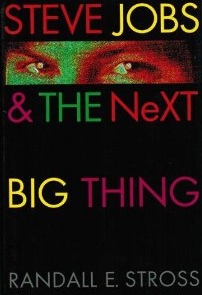 Randall E Stross wrote an article three days ago in the New York Times, that you hear a good deal about in most of the Apple blogosphere. Its title: “What Steve Jobs learned in the Wilderness“. I’ll add my two cents worth, as usual.
Randall E Stross wrote an article three days ago in the New York Times, that you hear a good deal about in most of the Apple blogosphere. Its title: “What Steve Jobs learned in the Wilderness“. I’ll add my two cents worth, as usual.
First, a word on Randall. The guy knows what he’s talking about, since, as he points out in the article, he wrote Steve Jobs and the NeXT Big Thing over 15 years ago. I read the book some time ago and liked it a lot. It’s a great resource on the obscure NeXT period (one I love, as you know or will soon know if you keep coming back to this blog). What Mr. Stross doesn’t brag about, understandingly, is that his main point in the book was that Steve Jobs was basically a fluke with no management skills and vision on the industry whatsoever. He thought that not only NeXT but also Pixar, where his wife worked, both proved it. Hmm.
Now about the article itself. Quite frankly, I have mixed feelings about it. It’s true that Steve was kind of humbled by his failure at NeXT. But, unlike what the article says, I don’t believe that this newfound humbleness has remained with him all these years. I agree more with Alan Deutschman’s theory in The Second Coming of Steve Jobs that once success came back, Steve Jobs’ “mellowness” was quick to disappear. I especially disagree with Randall Stross’ statement:
In this period, Mr. Jobs did not do much delegating. Almost every aspect of the machine — including the finish on interior screws — was his domain. (…) Mr. Jobs had learned from Next not to try to do everything himself.
This shows quite a lack of understanding of how Apple is run. Last time I checked, Steve delayed the launch of the iPad until he could find the appropriate word to describe it (namely, “magical”), chooses the music that’s used in every Apple commercial — and, yes, still cares a great deal about screws. Just listen to the keynotes or promotional videos for the iPhone or the Macbook Pro, how they insist on the number of screws (or the lack thereof) in the machines, with the very same words that were used by Steve when he launched the NeXT Station… in 1991.
As I’ve pointed out before, the main difference between Steve’s failures in the 1990s and his successes in the 2000s is not Steve himself. It’s… LUCK. And a market finally ready for his vision.
Pictures of the expansion of Pixar’s campus
The best Pixar online resource I know of (if you know a better one, let me know in comments) reports new pictures of the expansion of the Pixar campus in Emeryville.
Pixar expansion construction photos (Sept. 2010)
I am writing on this because it gives me the occasion to go back on three things:
- I was a little skeptical in 2006, when the Pixar/Disney merger occurred, that Pixar would lose its identity. Apparently, it’s not the case — not only are the movies still great, but the company still enjoys the paradise-like environment of its genius-filled Emeryville campus, far from the bean counters of Burbank. I think it’s a powerful statement of independence. For the record, Steve himself could not force the then-small Pixar team to move to the South Bay in the early 1990s. They refused because being away from him gave them greater freedom to work on what they chose to. History proved them right.

- The “fence-gate”, so to speak. Perhaps you don’t know, or don’t remember, but this expansion was first blocked by the neighbors of the Emeryville campus. They complained that Pixar lived in its own world, isolated from the city community by the huge fence surrounding their campus. Tom Carlisle, in charge of Pixar’s facilities, made Pixar’s case pretty simply: ““If the city takes away our fence, we will not stay in Emeryville.” I am quoting the guy because he’s known Steve for a long time. He was in charge of NeXT’s headquarters back in the 1990s, as you can see on the pic on the right.
- Pixar’s campus is great, but what about Apple’s planned new campus? Gee, it takes even longer than the future Woodside home to appear 😉 (more on that soon btw). So far, no sign of progress whatsoever. Apple has moved to the former HP offices that they were supposed to tear down, well, for four years… My opinion: Steve doesn’t have enough time to concentrate on both new Apple products and a perfect new campus. Not to mention his own home. This will take years, perhaps construction will not even start before he’s retired.
I’d also like to point out again that this blog is really about Steve Jobs, not Apple. Pixar, though less important, is Steve’s other company, and deserves to be mentioned on this blog just as much. Who doesn’t love Pixar anyway?
Stop comparing yourself with Steve Jobs
The prestigious Harvard Business Review recently published an interesting article: Stop Comparing Yourself With Steve Jobs by Dan Pallotta. The main idea is that you should draw inspiration from the people you admire, but certainly not compare yourself with them. The reason the article uses Steve Jobs is explained in the first paragraph already:
Comparing yourself with Steve Jobs is not healthy. Never mind that it’s probably the pastime of every alpha male and female businessperson on the planet these days.
There are two reasons why the article caught my eye:
– one, some people who (sadly) don’t spend enough time on the website think that the section “Being Steve” refers to “how to emulate Steve Jobs”. Maybe the name is a bad choice — though I like it and don’t intend to change it, sorry folks. But if you spend a couple minutes on the website, you’ll see it’s a description of Steve’s personality, things that have to be dealt with on all about Steve Jobs but have nothing to do on the biography. So — no, it’s not a manual on how to “be like Steve”.
– second, and more importantly, during my current studies in business school, I do have often heard Steve Jobs quoted in many a class by my teachers as a great inspiration. This is quite ironic to me.
(more…)

